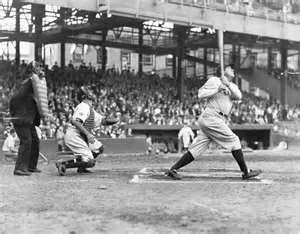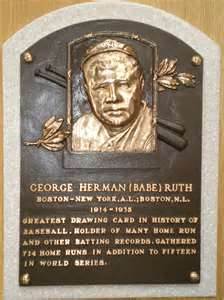Babe Ruth: Baseball's Titanic Presence
Part 3: Larger than Life
That changed when Ruth came along. His powerful combination of strong muscles, a heavy bat, and an efficient swing enable him to hit the ball farther, more often than other players before him. As a result, he could generate a run with one swing of the bat. He was often called "the Sultan of Swat." He led the major leagues in home runs 12 times and became the league's most-feared hitter. As a result, he also drew a great number of walks, as pitchers avoided throwing him pitches he could hit out of the ballpark. A larger-than-life figure, he was a well-known public persona off the field as well, ready with a well-timed quote and an extravagant lifestyle that bordered, at times, on recklessness. Quick to anger, he had more than his share of fights both on and off the field. He was ejected from games many times, for such transgressions as throwing dirt on an umpire and climbing into the stands to fight a heckler. One goal that eluded him was managing a team. His last job in pro baseball was as first base coach for the Brooklyn Dodgers, in 1938. A larger-than-life personality, Ruth was famous off the diamond as well. He appeared in radio shows and movies, including Pride of the Yankees, the Lou Gehrig story. He started the Babe Ruth Foundation, which benefited disadvantage children. Ruth was married, to Helen Woodford, in 1914. They separated in 1926. They had two adopted daughters. Helen died in 1929, and Ruth married his second wife, Claire. They remained together. In 1946, doctors discovered a cancerous tumor in Ruth's neck. His health steadily declined, and the Yankees summoned him back to Yankee Stadium on June 13, 1948 to retire his jersey number, 3. (The Yankees were the first team to use uniform numbers on a regular basis.) He died two months later. More than 100,000 people attended his funeral.
Stories about Babe Ruth, true or not, are many. One of the most famous took place in Game 3 of the 1932 World Series, against the Chicago Cubs. The Cubs fans were loudly heckling Ruth, and he pointed to center field. He hit the very next pitch exactly where he had pointed, to the deepest part of center field, nearly 500 feet away. Interpretations of these actions differ, with one interpretation that Ruth was pointing at the pitcher, not at the fans. Another story is set during the 1926 World Series, when Ruth heard about a boy named Johnny Sylvester, who was in the hospital with a serious illness and not expected to live much longer. Ruth promised Johnny he would hit a home run for him. He hit three that day. One of Ruth's most famous quotes came in 1930. He was making $80,000 a year, much more than other players. President Herbert Hoover's salary was $75,000. To a reporter who asked Ruth if he thought he was overpaid compared to the President, Ruth is said to have replied, "Why not? I had a better year than he did." First page > In the Beginning > Page 1, 2, 3 |
|
Social Studies for Kids
copyright 2002–2024
David White



 Ruth is credited with changing the way baseball was played. In the early years, pitchers used the same baseball inning after inning, no matter how "dead" the ball was after batters made contact after contact. Teams at that time emphasized "small ball," relying on many hits, speedy runners, and stolen bases to score runs. More home runs were scored by players who rounded the bases on a ball hit in a gap in the outfield than were scored by batters who hit the balls over the outfield fence.
Ruth is credited with changing the way baseball was played. In the early years, pitchers used the same baseball inning after inning, no matter how "dead" the ball was after batters made contact after contact. Teams at that time emphasized "small ball," relying on many hits, speedy runners, and stolen bases to score runs. More home runs were scored by players who rounded the bases on a ball hit in a gap in the outfield than were scored by batters who hit the balls over the outfield fence. He is still remembered far and wide for his baseball prowess and his off-the-field presence. Great players in other sports have long been called "the Babe Ruth of" their particular sport. Numerous baseball awards are named after him. His birthplace is now a museum.
He is still remembered far and wide for his baseball prowess and his off-the-field presence. Great players in other sports have long been called "the Babe Ruth of" their particular sport. Numerous baseball awards are named after him. His birthplace is now a museum.
